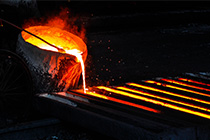Nov . 08, 2024 18:20 Back to list
modern steel making
Modern Steel Making Transformation and Techniques
Steel has long been considered the backbone of modern civilization. Its strength, durability, and versatility make it an indispensable material in construction, automotive, and various industries. The evolution of steel making has undergone significant transformations, particularly with the advent of modern technological advancements. This article delves into the key processes, innovations, and sustainability efforts associated with modern steel making.
The Basics of Steel Production
Steel is primarily produced from iron ore, which is refined to create the alloy of iron and carbon. The modern steel-making process typically involves two main methods the Basic Oxygen Process (BOP) and the Electric Arc Furnace (EAF) method.
1. Basic Oxygen Process (BOP) This technique involves converting molten iron from a blast furnace into steel. The process begins with the transfer of molten iron into a converter vessel. Pure oxygen is then blown into the molten iron at high pressure, which oxidizes impurities such as carbon and sulfur, thus refining the iron. The addition of steel scrap can enhance the quality and properties of the steel produced. This method is favored for its efficiency and ability to produce large quantities of steel rapidly.
2. Electric Arc Furnace (EAF) The EAF method is increasingly popular due to its flexibility and lower carbon footprint. This process involves melting scrap steel and direct reduced iron using electric arcs generated by large electrodes. EAFs can be operated using renewable energy sources, making them a more sustainable option. As a result, this method has seen significant adoption, especially in regions with abundant recycled steel resources.
Technological Innovations
Modern steel making is characterized by the integration of advanced technologies to improve efficiency and reduce environmental impact. Automation and artificial intelligence play pivotal roles in optimizing production processes. For instance, real-time monitoring systems can evaluate the furnace temperature and composition of materials, allowing for adjustments that ensure optimal quality and reduce energy consumption.
modern steel making

Additionally, innovations such as Continuous Casting have revolutionized the way steel is shaped post-production. This process allows for the continuous pouring of molten steel into molds, which solidifies as it moves through the casting system. This technique minimizes waste and enhances productivity, producing high-quality steel billets and slabs with uniform properties.
Sustainability Initiatives
The steel industry has faced increasing scrutiny regarding its environmental impact, particularly concerning greenhouse gas emissions. In response, many companies are actively pursuing sustainability initiatives. One major focus has been the reduction of CO2 emissions through the adoption of cleaner production methods.
Carbon capture and storage (CCS) technologies are being explored to reduce emissions from traditional blast furnaces. Meanwhile, the use of hydrogen in steel making is garnering attention as a potential game changer. By employing hydrogen as a reducing agent instead of carbon, industries could significantly cut down on their carbon footprint. Several pilot projects are underway to evaluate the feasibility of hydrogen-reduced steel production.
Moreover, steel recycling has become an essential practice, with recycled scrap accounting for a substantial portion of today’s steel production. The recycling process requires significantly less energy compared to producing new steel from raw materials, bolstering the industry's sustainability efforts.
Conclusion
Modern steel making is a dynamic field that continues to evolve through technological advancements and sustainable practices. The integration of innovative methods like BOP and EAF, along with a focus on reducing environmental impact, positions the steel industry to meet the demands of a growing global population while adhering to stricter sustainability standards. As we move forward, the commitment to innovation and responsibility will be crucial in ensuring that steel remains a vital component of our infrastructure and everyday lives. The future of steel making promises not only enhanced performance and efficiency but also a greater alignment with global sustainability goals.
-
Fe-C Composite Pellets for BOF: Enhance Efficiency, Lower Steelmaking Costs
NewsAug.25,2025
-
Durable Building Material for Round Wall Exporters | Custom Shapes
NewsAug.24,2025
-
Tundish Dry Vibrator: Boost Steel Casting Performance
NewsAug.23,2025
-
Thermal Insulation Cups Materials Exporters - Quality & Durable Supplies
NewsAug.22,2025
-
High-Purity Graphitized Petroleum Coke & Low Nitrogen Recarburiser
NewsAug.21,2025
-
High-Performance Fe-C Composite Pellets for BOF
NewsAug.19,2025
